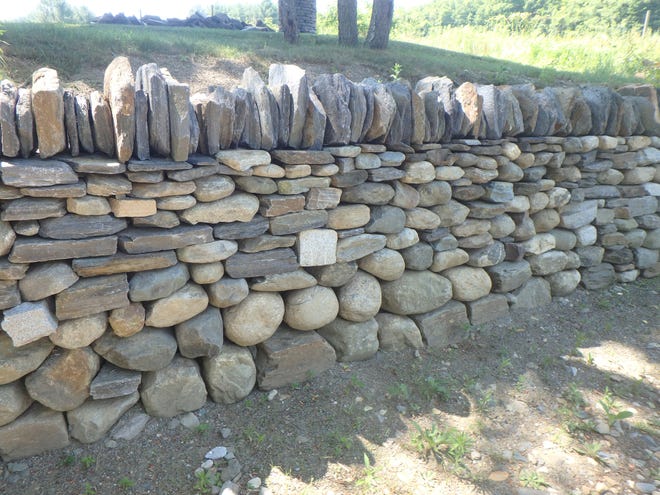To build a stone wall, a solid foundation is essential
Several years ago, when I was young and silly, I decided to build an 80 foot long terrace for the fruit trees, and border it with a beautiful fieldstone retaining wall using stones that I might find on my property or on a friend’s neighboring property. It was a lot of work, a lot of fun and I made a lot of mistakes. This wall is still standing 30 years later, but I had to fix it several times.
If you want to build a retaining wall, do your homework! Learn about the process before you begin. This article will give you some basics, but taking a workshop, working with an expert wall, or reading a book or two will help you a lot.
I recently traveled to Dummerston, Vermont to talk to drystone walling master Dan Snow. He is one of the founding members of The Stone Trust on the Scott farm in Dummerston. Here are some of his suggestions.
To build a wall that stands the test of time, it is important to start the wall on a good foundation that drains well. He recommends digging a trench and filling it with crushed stone ½ to ¾ inch in diameter. It is not gravel, which contains “fines”, i.e. particles of sand and clay. You don’t want that.
The higher the wall, the deeper the crushed stone base should be. The general rule he suggested is that the depth of the crushed stone should be half the height of the wall. Build a three foot retaining wall? An 18-inch ditch filled with crushed rock is a good start.
The exception to the rule of starting with a crushed stone footing is if you are placing the wall on a heavy clay base. Clay can creep into the spaces between stones and clog drainage. Sand, however, will not do this and can be used as a base. If the wall sits on a flooded base in the spring, you may need to install drains to drain the water.
Snow suggested the 1-2-3 rule for retaining walls. These numbers refer to the proportions of the wall: top width to bottom width to height. A one meter high wall should be about 60cm wide at the base and 30cm wide at the top.
When constructing a wall, whether freestanding or retaining, it is important that each course of stone be level. And a gentle slope or step outward from the wall is also needed. Many wallers use ropes and a wooden frame to establish the batter or slope of the wall. In general, for every 12 inches of wall height, two inches of point back is good.
Another basic principle of building walls, as explained on The Stone Trust website (www.thestonetrust.org), is to turn long stones into the wall instead of placing them the full length of the wall. This is a mistake I made many times when building my retaining wall. A nice 30 inch stone placed lengthwise along the wall gives you a nice look, but it doesn’t hold the wall in place like it would if inserted back and forth into the wall.
The snow also reminded me of the old adage: “Two stones on one, one stone on two”. This means never stacking stones of similar size on top of each other. You want each stone to be in contact with more than one stone above and below.
I asked Snow to use landscape fabric behind a retaining wall. I thought this was a good practice as it can prevent soil from entering the wall, filling in gaps and clogging drainage. If a wall holds water behind it and freezes, he explained, frost can push a wall forward. But Snow isn’t big on landscape fabric; he just prefers to establish really good drainage so that it won’t be a problem.
Many gardeners who have a hilly site want stone steps to make it easier to walk up or down hills without slipping on wet grass. We reviewed the steps at The Stone Trust, and Snow explained the basics: start at the bottom and work your way up. Make sure each subsequent stone rests on the back of the stone below it. The weight of the top stone will hold the bottom stone in place. Finally, make sure the front of each riser is either vertical or suspended above the stones supporting it. He said it’s important when you go down that your heel doesn’t hit a piece of rock that’s in front of the edge of the step.
For the past nine years The Stone Trust has offered multi-day courses and workshops for home gardeners and dry stone masons to learn the skills needed to work with stone. I wish I had taken a workshop before trying to build a wall.
Snow has two excellent books on stonework: “Listening to Stone: Hardy Structures, Perilous Follies and Other Tangles with Nature” and “In the Company of Stone: The Art of the Stone Wall.” Much of what he builds is art or fantasy, and the photos of Peter Mauss are remarkable. Snow’s website is https://www.dansnowstoneworks.com
Another excellent resource for working with stone is Gordon Hayward, who is a neighbor and friend of Snow, an excellent garden designer and the author of many fabulous books. His book “Stone in the Garden: Inspiring Designs and Practical Projects” is full of great photos and very specific and helpful advice. I highly recommend it.
Don’t be intimidated by the stone. Learn how to use it well and you’ll love it every time you step into your garden — even if your walls aren’t perfect.
— Henry Homeyer’s blog appears twice a week at dailyuv.com/gardeningguy. Write to him at PO Box 364, Cornish Flat, NH 03746. Please include a SASE if you would like a response by post. Or email [email protected].




Comments are closed.